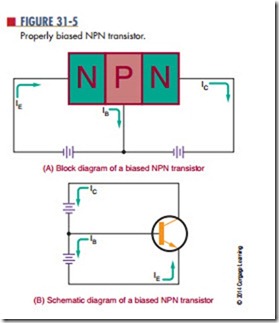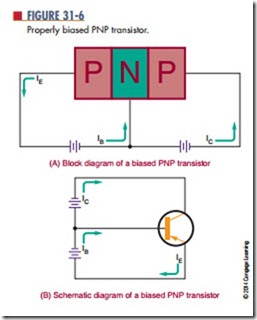Basic Transistor operation
A diode is a rectifier, and a transistor is an amplifier. A transistor may be used in a variety of ways, but its basic functions are to provide current amplification of a signal or to switch the signal.
A transistor must be properly biased by external voltages so that the emitter, base, and collector regions interact in the desired manner. In a properly biased transistor, the emitter junction is forward biased and the collector junction is reverse biased. A properly biased NPN transistor is shown in Figure 31-5.
Electrons are caused to f low from an NPN transistor emitter by a forward bias. Forward bias is a positive voltage on the base terminal with respect to the emitter terminal. A positive potential attracts electrons, creating an electron flow from the emitter. The electrons that are attracted into the base are now influenced by the positive potential applied to the collector. The majority of electrons are attracted to the collector and into the positive side of the reverse- biased voltage source. A few electrons are absorbed into the base region and support a small electron flow from it. For this action to occur, the base region must be extremely thin. In a properly biased PNP transistor, the batteries must be reversed (Figure 31-6).
The difference between the NPN and PNP transistors is twofold: The batteries have opposite polarities, and the direction of the electron flow is reversed.
As with the diode, a barrier voltage exists within the transistor. In a transistor, the barrier voltage is produced across the emitter-base junction. This voltage must be exceeded before electrons can flow through the junction. The internal barrier voltage is determined by the type of semiconductor material used. As in diodes, the internal barrier voltage is 0.3 V for germanium transistors and 0.7 V for silicon transistors.
The collector-base junction of a transistor must also be subjected to a positive potential that is high enough
to attract most of the electrons supplied by the emitter. The reverse-bias voltage applied to the collector-base junction is usually much higher than the forward-bias voltage across the emitter-base junction, supplying this higher voltage.
Questions
1. What are the basic functions of a transistor?
2. What is the proper method for biasing a transistor?
3. What is the difference between biasing an NPN transistor and biasing a PNP transistor?
4. What are the barrier voltages for a germanium transistor and a silicon transistor?
5. What is the difference between the collector-base and emitter-base junction bias voltages?

